University of Westminster: Zara's Operations Management Report
VerifiedAdded on 2022/01/20
|10
|3991
|83
Report
AI Summary
This report provides a detailed analysis of Inditex Group, with a specific focus on its Zara brand. It examines Zara's supply chain management, including design, production, distribution, and retail processes, highlighting the company's vertical integration and its impact on fast fashion. The report explores the benefits of Zara's supply chain strategies, such as Just-In-Time production, information systems, and stock management. It also discusses the importance of real-time communication within the organization. The report concludes with recommendations for improving Inditex Group's operations and management. The report delves into Zara's strategies, including its rapid response to fashion trends, the creation of a perceived scarcity of products, and the offering of a wide variety of designs. The company's operational management is also analyzed, showcasing how it enhances revenue by reducing production discounts compared to competitors.
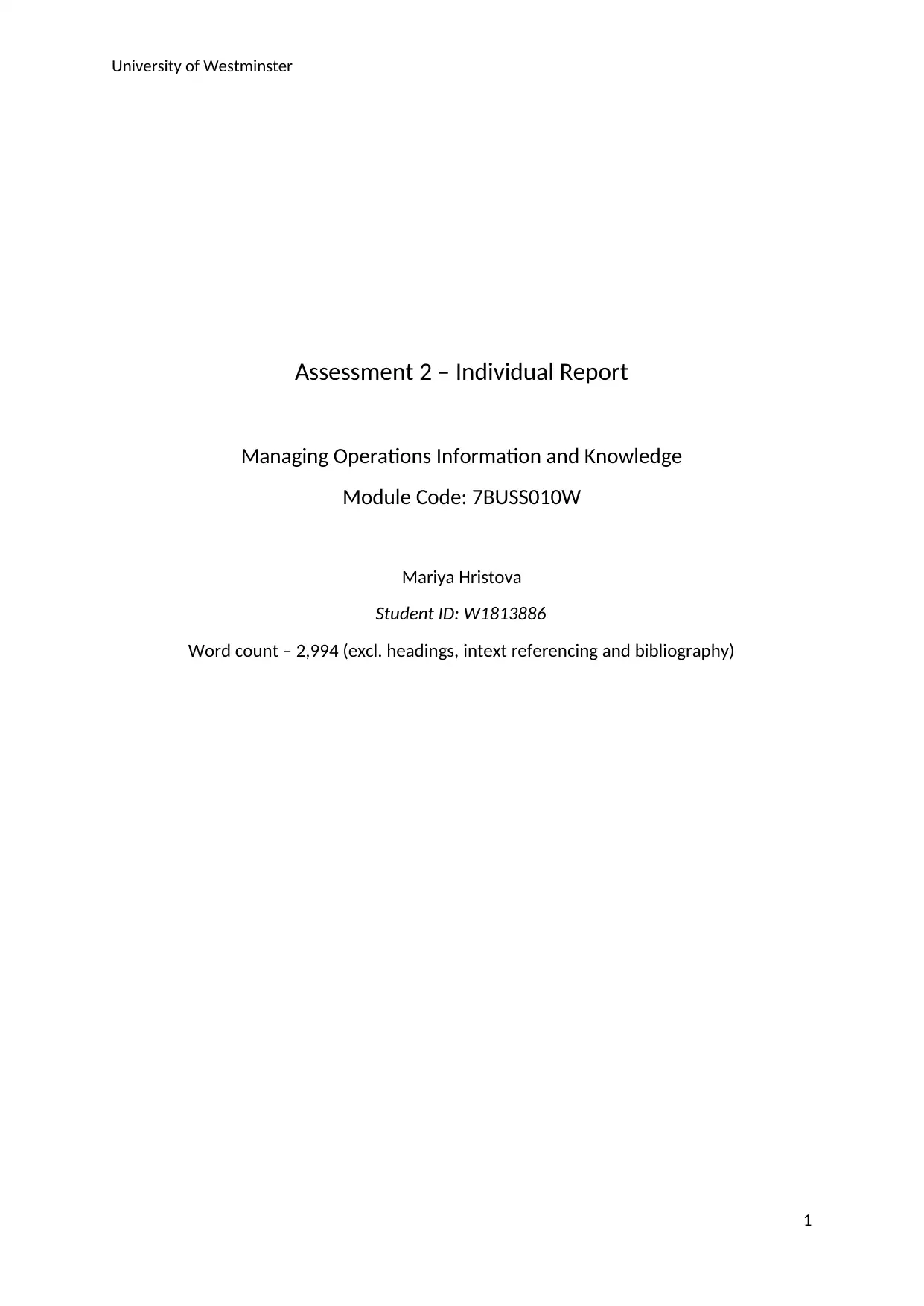
University of Westminster
Assessment 2 – Individual Report
Managing Operations Information and Knowledge
Module Code: 7BUSS010W
Mariya Hristova
Student ID: W1813886
Word count – 2,994 (excl. headings, intext referencing and bibliography)
1
Assessment 2 – Individual Report
Managing Operations Information and Knowledge
Module Code: 7BUSS010W
Mariya Hristova
Student ID: W1813886
Word count – 2,994 (excl. headings, intext referencing and bibliography)
1
Paraphrase This Document
Need a fresh take? Get an instant paraphrase of this document with our AI Paraphraser
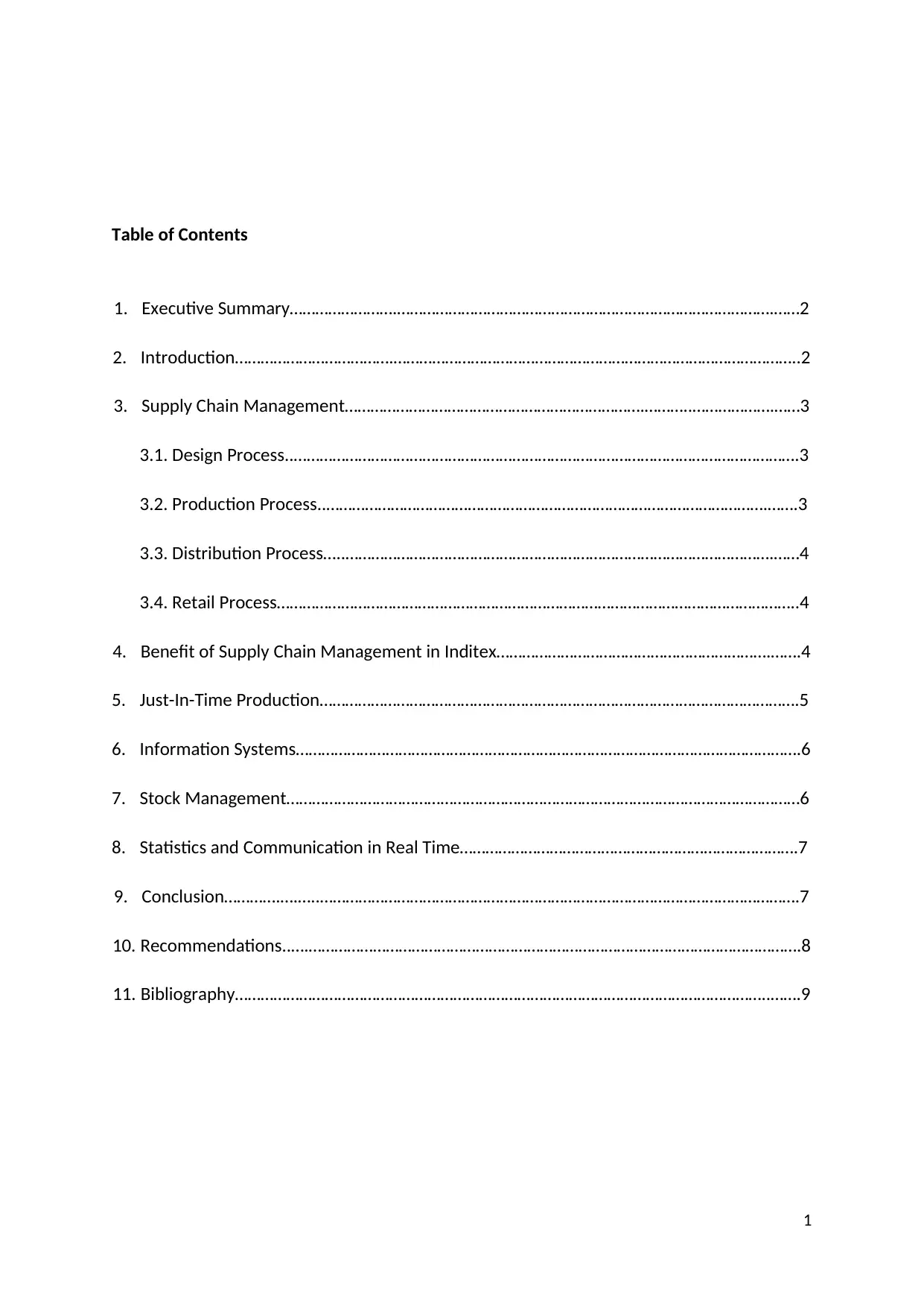
Table of Contents
1. Executive Summary…………………….…………………………………………………………………………….……2
2. Introduction……………………………….…………………………………………………………………………………..2
3. Supply Chain Management…………………………………………………………….………..……………….……3
3.1. Design Process..……………………………………………………………………………………………………….3
3.2. Production Process..………………………………………………………………………………………….…….3
3.3. Distribution Process…..……………………………………………………………………………………….……4
3.4. Retail Process…………………………………………………………………………………………………………..4
4. Benefit of Supply Chain Management in Inditex……………………………………………………….…….4
5. Just-In-Time Production………………………………………………………………………………………………….5
6. Information Systems……………………………………………………………………………………………………….6
7. Stock Management…………………………………………………………………………………………………………6
8. Statistics and Communication in Real Time…………………………………………………………………….7
9. Conclusion………….….…..………………………………………………………………………………………………….7
10. Recommendations..….…………………………………………………………………………………………………….8
11. Bibliography……………………………………………………………………………………………………………..…….9
1
1. Executive Summary…………………….…………………………………………………………………………….……2
2. Introduction……………………………….…………………………………………………………………………………..2
3. Supply Chain Management…………………………………………………………….………..……………….……3
3.1. Design Process..……………………………………………………………………………………………………….3
3.2. Production Process..………………………………………………………………………………………….…….3
3.3. Distribution Process…..……………………………………………………………………………………….……4
3.4. Retail Process…………………………………………………………………………………………………………..4
4. Benefit of Supply Chain Management in Inditex……………………………………………………….…….4
5. Just-In-Time Production………………………………………………………………………………………………….5
6. Information Systems……………………………………………………………………………………………………….6
7. Stock Management…………………………………………………………………………………………………………6
8. Statistics and Communication in Real Time…………………………………………………………………….7
9. Conclusion………….….…..………………………………………………………………………………………………….7
10. Recommendations..….…………………………………………………………………………………………………….8
11. Bibliography……………………………………………………………………………………………………………..…….9
1
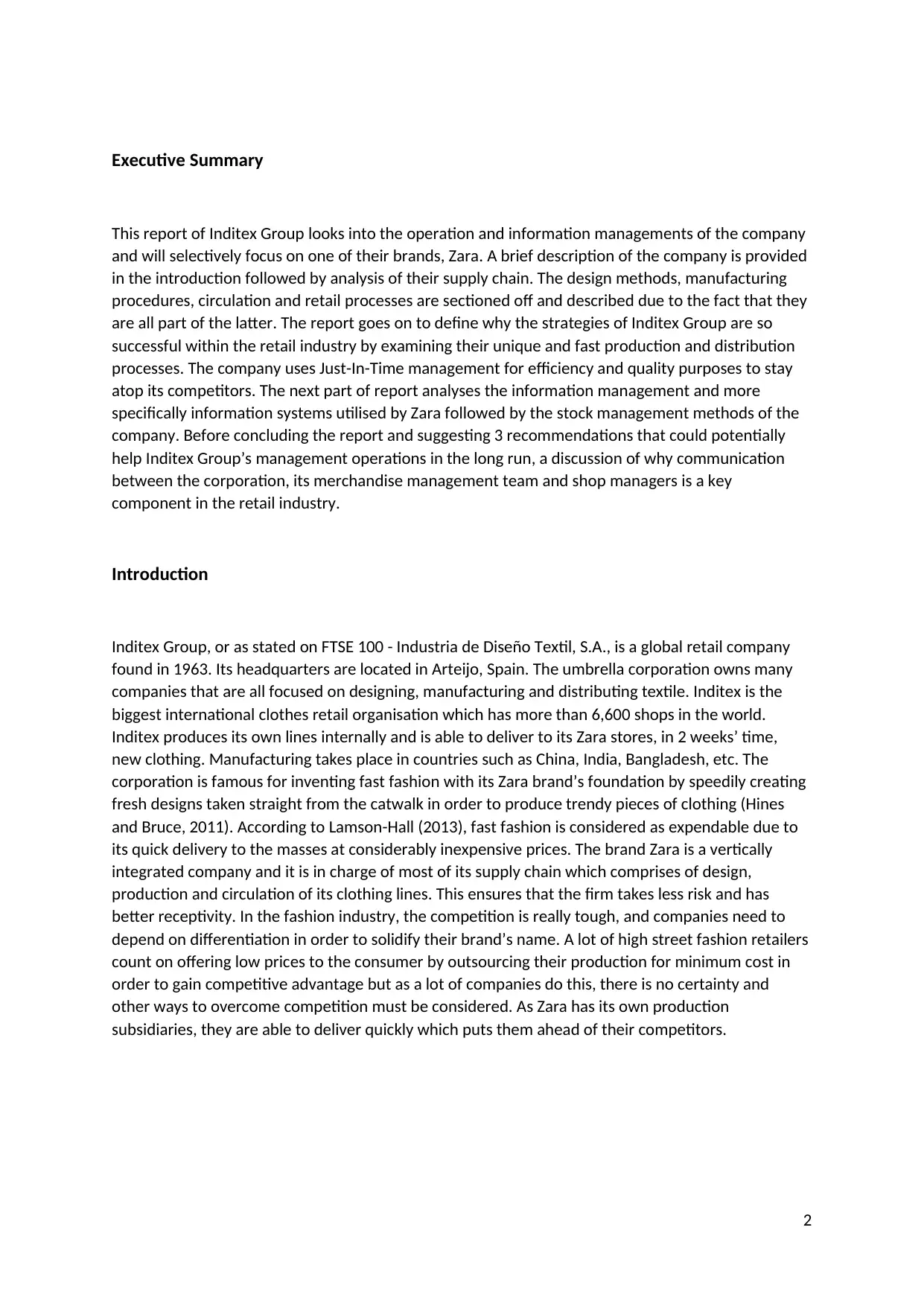
Executive Summary
This report of Inditex Group looks into the operation and information managements of the company
and will selectively focus on one of their brands, Zara. A brief description of the company is provided
in the introduction followed by analysis of their supply chain. The design methods, manufacturing
procedures, circulation and retail processes are sectioned off and described due to the fact that they
are all part of the latter. The report goes on to define why the strategies of Inditex Group are so
successful within the retail industry by examining their unique and fast production and distribution
processes. The company uses Just-In-Time management for efficiency and quality purposes to stay
atop its competitors. The next part of report analyses the information management and more
specifically information systems utilised by Zara followed by the stock management methods of the
company. Before concluding the report and suggesting 3 recommendations that could potentially
help Inditex Group’s management operations in the long run, a discussion of why communication
between the corporation, its merchandise management team and shop managers is a key
component in the retail industry.
Introduction
Inditex Group, or as stated on FTSE 100 - Industria de Diseño Textil, S.A., is a global retail company
found in 1963. Its headquarters are located in Arteijo, Spain. The umbrella corporation owns many
companies that are all focused on designing, manufacturing and distributing textile. Inditex is the
biggest international clothes retail organisation which has more than 6,600 shops in the world.
Inditex produces its own lines internally and is able to deliver to its Zara stores, in 2 weeks’ time,
new clothing. Manufacturing takes place in countries such as China, India, Bangladesh, etc. The
corporation is famous for inventing fast fashion with its Zara brand’s foundation by speedily creating
fresh designs taken straight from the catwalk in order to produce trendy pieces of clothing (Hines
and Bruce, 2011). According to Lamson-Hall (2013), fast fashion is considered as expendable due to
its quick delivery to the masses at considerably inexpensive prices. The brand Zara is a vertically
integrated company and it is in charge of most of its supply chain which comprises of design,
production and circulation of its clothing lines. This ensures that the firm takes less risk and has
better receptivity. In the fashion industry, the competition is really tough, and companies need to
depend on differentiation in order to solidify their brand’s name. A lot of high street fashion retailers
count on offering low prices to the consumer by outsourcing their production for minimum cost in
order to gain competitive advantage but as a lot of companies do this, there is no certainty and
other ways to overcome competition must be considered. As Zara has its own production
subsidiaries, they are able to deliver quickly which puts them ahead of their competitors.
2
This report of Inditex Group looks into the operation and information managements of the company
and will selectively focus on one of their brands, Zara. A brief description of the company is provided
in the introduction followed by analysis of their supply chain. The design methods, manufacturing
procedures, circulation and retail processes are sectioned off and described due to the fact that they
are all part of the latter. The report goes on to define why the strategies of Inditex Group are so
successful within the retail industry by examining their unique and fast production and distribution
processes. The company uses Just-In-Time management for efficiency and quality purposes to stay
atop its competitors. The next part of report analyses the information management and more
specifically information systems utilised by Zara followed by the stock management methods of the
company. Before concluding the report and suggesting 3 recommendations that could potentially
help Inditex Group’s management operations in the long run, a discussion of why communication
between the corporation, its merchandise management team and shop managers is a key
component in the retail industry.
Introduction
Inditex Group, or as stated on FTSE 100 - Industria de Diseño Textil, S.A., is a global retail company
found in 1963. Its headquarters are located in Arteijo, Spain. The umbrella corporation owns many
companies that are all focused on designing, manufacturing and distributing textile. Inditex is the
biggest international clothes retail organisation which has more than 6,600 shops in the world.
Inditex produces its own lines internally and is able to deliver to its Zara stores, in 2 weeks’ time,
new clothing. Manufacturing takes place in countries such as China, India, Bangladesh, etc. The
corporation is famous for inventing fast fashion with its Zara brand’s foundation by speedily creating
fresh designs taken straight from the catwalk in order to produce trendy pieces of clothing (Hines
and Bruce, 2011). According to Lamson-Hall (2013), fast fashion is considered as expendable due to
its quick delivery to the masses at considerably inexpensive prices. The brand Zara is a vertically
integrated company and it is in charge of most of its supply chain which comprises of design,
production and circulation of its clothing lines. This ensures that the firm takes less risk and has
better receptivity. In the fashion industry, the competition is really tough, and companies need to
depend on differentiation in order to solidify their brand’s name. A lot of high street fashion retailers
count on offering low prices to the consumer by outsourcing their production for minimum cost in
order to gain competitive advantage but as a lot of companies do this, there is no certainty and
other ways to overcome competition must be considered. As Zara has its own production
subsidiaries, they are able to deliver quickly which puts them ahead of their competitors.
2
⊘ This is a preview!⊘
Do you want full access?
Subscribe today to unlock all pages.

Trusted by 1+ million students worldwide
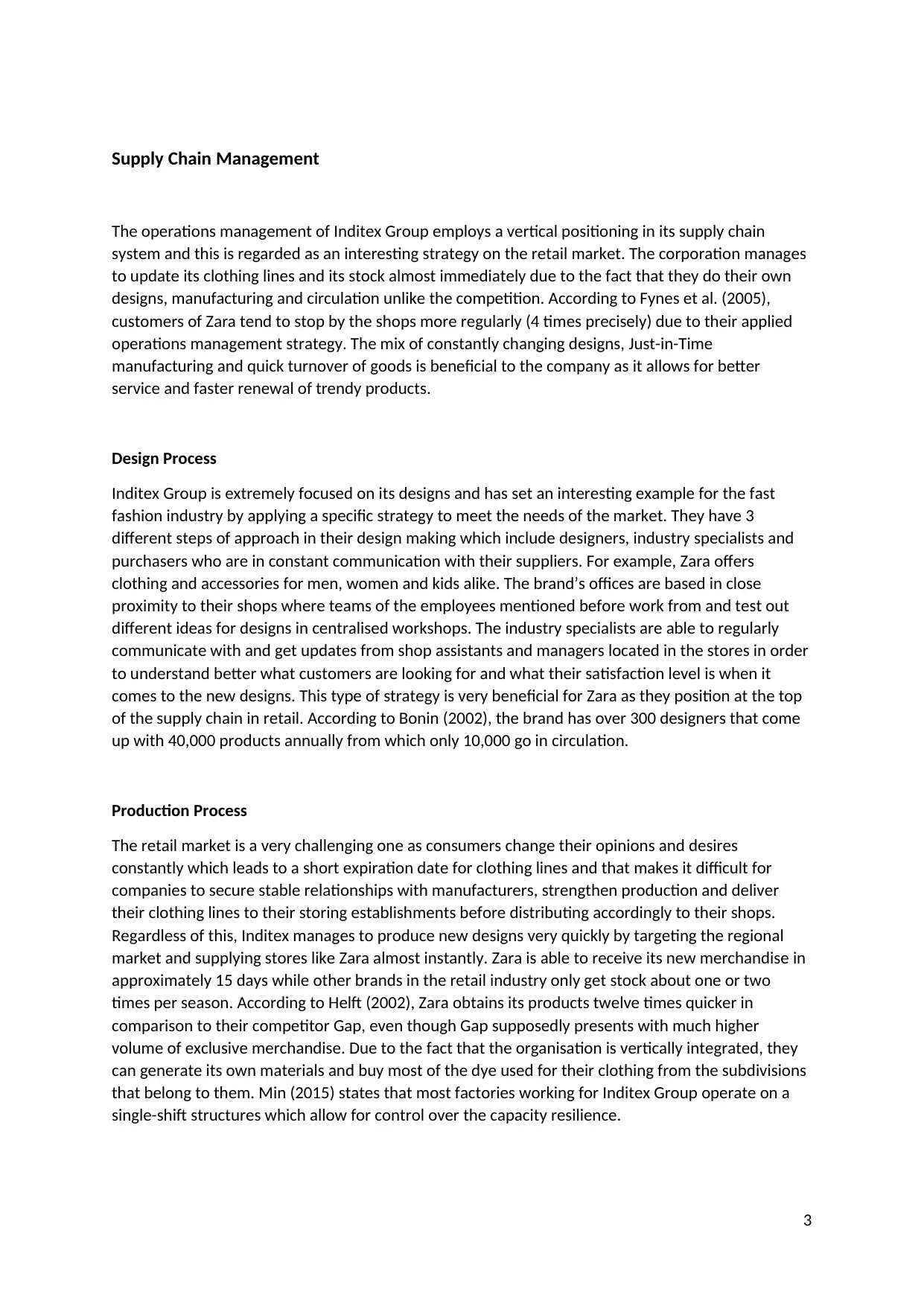
Supply Chain Management
The operations management of Inditex Group employs a vertical positioning in its supply chain
system and this is regarded as an interesting strategy on the retail market. The corporation manages
to update its clothing lines and its stock almost immediately due to the fact that they do their own
designs, manufacturing and circulation unlike the competition. According to Fynes et al. (2005),
customers of Zara tend to stop by the shops more regularly (4 times precisely) due to their applied
operations management strategy. The mix of constantly changing designs, Just-in-Time
manufacturing and quick turnover of goods is beneficial to the company as it allows for better
service and faster renewal of trendy products.
Design Process
Inditex Group is extremely focused on its designs and has set an interesting example for the fast
fashion industry by applying a specific strategy to meet the needs of the market. They have 3
different steps of approach in their design making which include designers, industry specialists and
purchasers who are in constant communication with their suppliers. For example, Zara offers
clothing and accessories for men, women and kids alike. The brand’s offices are based in close
proximity to their shops where teams of the employees mentioned before work from and test out
different ideas for designs in centralised workshops. The industry specialists are able to regularly
communicate with and get updates from shop assistants and managers located in the stores in order
to understand better what customers are looking for and what their satisfaction level is when it
comes to the new designs. This type of strategy is very beneficial for Zara as they position at the top
of the supply chain in retail. According to Bonin (2002), the brand has over 300 designers that come
up with 40,000 products annually from which only 10,000 go in circulation.
Production Process
The retail market is a very challenging one as consumers change their opinions and desires
constantly which leads to a short expiration date for clothing lines and that makes it difficult for
companies to secure stable relationships with manufacturers, strengthen production and deliver
their clothing lines to their storing establishments before distributing accordingly to their shops.
Regardless of this, Inditex manages to produce new designs very quickly by targeting the regional
market and supplying stores like Zara almost instantly. Zara is able to receive its new merchandise in
approximately 15 days while other brands in the retail industry only get stock about one or two
times per season. According to Helft (2002), Zara obtains its products twelve times quicker in
comparison to their competitor Gap, even though Gap supposedly presents with much higher
volume of exclusive merchandise. Due to the fact that the organisation is vertically integrated, they
can generate its own materials and buy most of the dye used for their clothing from the subdivisions
that belong to them. Min (2015) states that most factories working for Inditex Group operate on a
single-shift structures which allow for control over the capacity resilience.
3
The operations management of Inditex Group employs a vertical positioning in its supply chain
system and this is regarded as an interesting strategy on the retail market. The corporation manages
to update its clothing lines and its stock almost immediately due to the fact that they do their own
designs, manufacturing and circulation unlike the competition. According to Fynes et al. (2005),
customers of Zara tend to stop by the shops more regularly (4 times precisely) due to their applied
operations management strategy. The mix of constantly changing designs, Just-in-Time
manufacturing and quick turnover of goods is beneficial to the company as it allows for better
service and faster renewal of trendy products.
Design Process
Inditex Group is extremely focused on its designs and has set an interesting example for the fast
fashion industry by applying a specific strategy to meet the needs of the market. They have 3
different steps of approach in their design making which include designers, industry specialists and
purchasers who are in constant communication with their suppliers. For example, Zara offers
clothing and accessories for men, women and kids alike. The brand’s offices are based in close
proximity to their shops where teams of the employees mentioned before work from and test out
different ideas for designs in centralised workshops. The industry specialists are able to regularly
communicate with and get updates from shop assistants and managers located in the stores in order
to understand better what customers are looking for and what their satisfaction level is when it
comes to the new designs. This type of strategy is very beneficial for Zara as they position at the top
of the supply chain in retail. According to Bonin (2002), the brand has over 300 designers that come
up with 40,000 products annually from which only 10,000 go in circulation.
Production Process
The retail market is a very challenging one as consumers change their opinions and desires
constantly which leads to a short expiration date for clothing lines and that makes it difficult for
companies to secure stable relationships with manufacturers, strengthen production and deliver
their clothing lines to their storing establishments before distributing accordingly to their shops.
Regardless of this, Inditex manages to produce new designs very quickly by targeting the regional
market and supplying stores like Zara almost instantly. Zara is able to receive its new merchandise in
approximately 15 days while other brands in the retail industry only get stock about one or two
times per season. According to Helft (2002), Zara obtains its products twelve times quicker in
comparison to their competitor Gap, even though Gap supposedly presents with much higher
volume of exclusive merchandise. Due to the fact that the organisation is vertically integrated, they
can generate its own materials and buy most of the dye used for their clothing from the subdivisions
that belong to them. Min (2015) states that most factories working for Inditex Group operate on a
single-shift structures which allow for control over the capacity resilience.
3
Paraphrase This Document
Need a fresh take? Get an instant paraphrase of this document with our AI Paraphraser
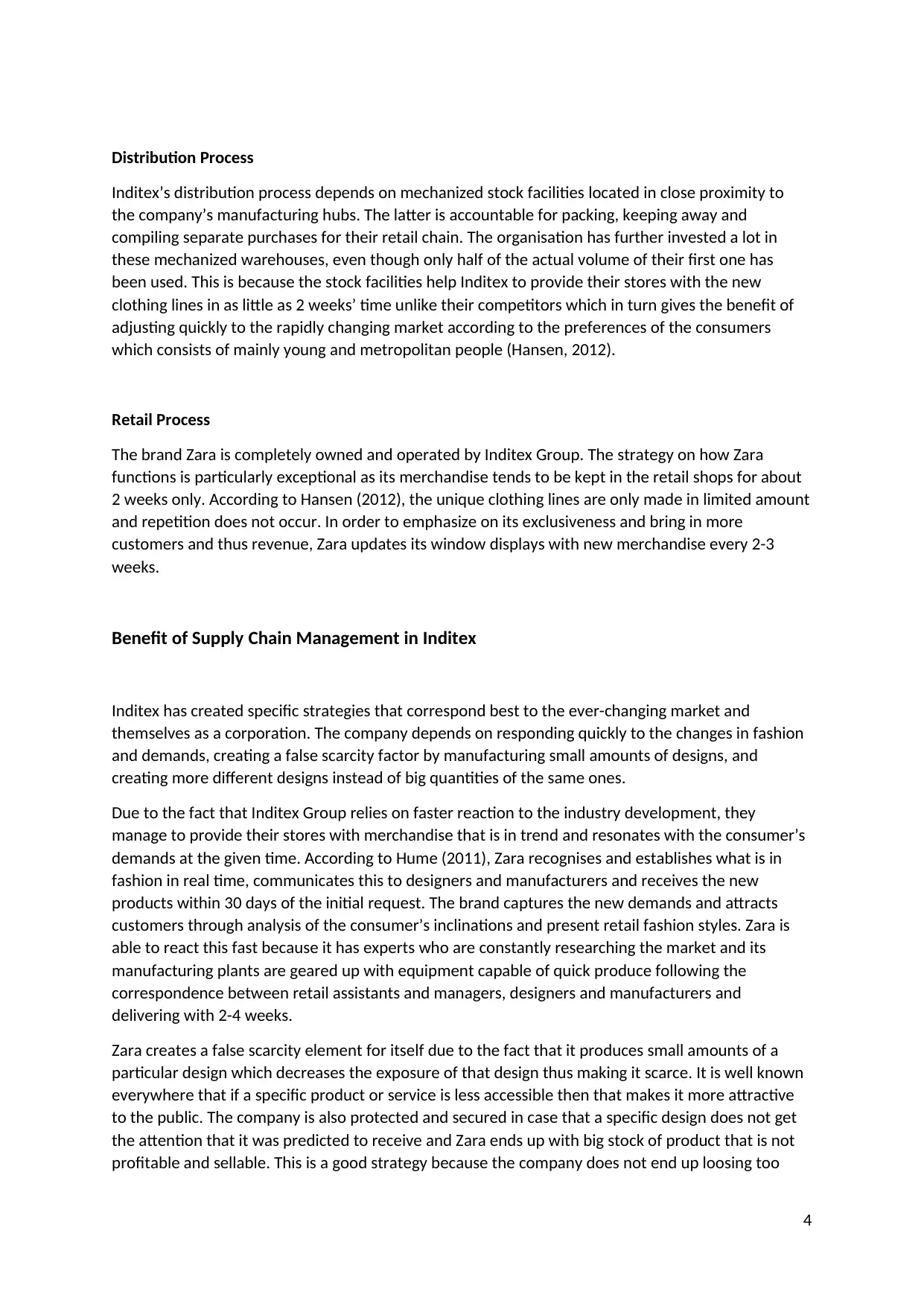
Distribution Process
Inditex’s distribution process depends on mechanized stock facilities located in close proximity to
the company’s manufacturing hubs. The latter is accountable for packing, keeping away and
compiling separate purchases for their retail chain. The organisation has further invested a lot in
these mechanized warehouses, even though only half of the actual volume of their first one has
been used. This is because the stock facilities help Inditex to provide their stores with the new
clothing lines in as little as 2 weeks’ time unlike their competitors which in turn gives the benefit of
adjusting quickly to the rapidly changing market according to the preferences of the consumers
which consists of mainly young and metropolitan people (Hansen, 2012).
Retail Process
The brand Zara is completely owned and operated by Inditex Group. The strategy on how Zara
functions is particularly exceptional as its merchandise tends to be kept in the retail shops for about
2 weeks only. According to Hansen (2012), the unique clothing lines are only made in limited amount
and repetition does not occur. In order to emphasize on its exclusiveness and bring in more
customers and thus revenue, Zara updates its window displays with new merchandise every 2-3
weeks.
Benefit of Supply Chain Management in Inditex
Inditex has created specific strategies that correspond best to the ever-changing market and
themselves as a corporation. The company depends on responding quickly to the changes in fashion
and demands, creating a false scarcity factor by manufacturing small amounts of designs, and
creating more different designs instead of big quantities of the same ones.
Due to the fact that Inditex Group relies on faster reaction to the industry development, they
manage to provide their stores with merchandise that is in trend and resonates with the consumer’s
demands at the given time. According to Hume (2011), Zara recognises and establishes what is in
fashion in real time, communicates this to designers and manufacturers and receives the new
products within 30 days of the initial request. The brand captures the new demands and attracts
customers through analysis of the consumer’s inclinations and present retail fashion styles. Zara is
able to react this fast because it has experts who are constantly researching the market and its
manufacturing plants are geared up with equipment capable of quick produce following the
correspondence between retail assistants and managers, designers and manufacturers and
delivering with 2-4 weeks.
Zara creates a false scarcity element for itself due to the fact that it produces small amounts of a
particular design which decreases the exposure of that design thus making it scarce. It is well known
everywhere that if a specific product or service is less accessible then that makes it more attractive
to the public. The company is also protected and secured in case that a specific design does not get
the attention that it was predicted to receive and Zara ends up with big stock of product that is not
profitable and sellable. This is a good strategy because the company does not end up loosing too
4
Inditex’s distribution process depends on mechanized stock facilities located in close proximity to
the company’s manufacturing hubs. The latter is accountable for packing, keeping away and
compiling separate purchases for their retail chain. The organisation has further invested a lot in
these mechanized warehouses, even though only half of the actual volume of their first one has
been used. This is because the stock facilities help Inditex to provide their stores with the new
clothing lines in as little as 2 weeks’ time unlike their competitors which in turn gives the benefit of
adjusting quickly to the rapidly changing market according to the preferences of the consumers
which consists of mainly young and metropolitan people (Hansen, 2012).
Retail Process
The brand Zara is completely owned and operated by Inditex Group. The strategy on how Zara
functions is particularly exceptional as its merchandise tends to be kept in the retail shops for about
2 weeks only. According to Hansen (2012), the unique clothing lines are only made in limited amount
and repetition does not occur. In order to emphasize on its exclusiveness and bring in more
customers and thus revenue, Zara updates its window displays with new merchandise every 2-3
weeks.
Benefit of Supply Chain Management in Inditex
Inditex has created specific strategies that correspond best to the ever-changing market and
themselves as a corporation. The company depends on responding quickly to the changes in fashion
and demands, creating a false scarcity factor by manufacturing small amounts of designs, and
creating more different designs instead of big quantities of the same ones.
Due to the fact that Inditex Group relies on faster reaction to the industry development, they
manage to provide their stores with merchandise that is in trend and resonates with the consumer’s
demands at the given time. According to Hume (2011), Zara recognises and establishes what is in
fashion in real time, communicates this to designers and manufacturers and receives the new
products within 30 days of the initial request. The brand captures the new demands and attracts
customers through analysis of the consumer’s inclinations and present retail fashion styles. Zara is
able to react this fast because it has experts who are constantly researching the market and its
manufacturing plants are geared up with equipment capable of quick produce following the
correspondence between retail assistants and managers, designers and manufacturers and
delivering with 2-4 weeks.
Zara creates a false scarcity element for itself due to the fact that it produces small amounts of a
particular design which decreases the exposure of that design thus making it scarce. It is well known
everywhere that if a specific product or service is less accessible then that makes it more attractive
to the public. The company is also protected and secured in case that a specific design does not get
the attention that it was predicted to receive and Zara ends up with big stock of product that is not
profitable and sellable. This is a good strategy because the company does not end up loosing too
4

much revenue when trying to market it during end-of-season sales. The operational management of
the brand is very-well systemised as they are able to gain better monies due to only reducing their
overall production with 18 percent in comparison to their competition which discount at double that
number (Fynes et al., 2005).
Inditex Group has an approach of manufacturing more different design models rather than higher
volumes of the same ones. For example, Zara introduces over 12,000 designs per annum on the
market which is beneficial as, due to the scarcity, the apparel is sold out fast and immediately
replaced with something new and fresh already waiting in the warehouses. Zara provides more
selection of in-trend clothing to the consumer that its competitors.
Just-in-Time Production
Inditex Group uses Just-In-Time management, which is a strictly regulated unification method, to
manufacture and bring new trendy designs to its customers which are adapted to the current
fashion styles. Another example of this type of management is the car manufacturer, Toyota, which
was one of the first companies to apply it. Feigenbaum and Feigenbaum (2005) state that the
standards that were set by this firm originate from Total Quality management, Just-In-Time
management and Lean management. The two latter types are used by various companies in all
sectors in their manufacturing systems. Toyota managed to surpass a big part of its competition on
the market and acquired very high revenue as an international bulk car manufacturer which only
took them a few decades to do. They were successful in achieving this due to the conviction that
their strategies are profitable if considering a long-term plan (Feigenbaum and Feigenbaum, 2005).
According to Feigenbaum and Feigenbaum (2005), the second most important factor that puts
Inditex in front of its competitors in the industry is Just-In-Time Production, which helps the
organisation improve its efficiency and spot faults early. As a consequence of this quality-oriented
approach to business conduct, financially the company has improved. Inditex Group creates all of its
products in-house, and the design strategy is realised by applying a merchandise design method that
includes the whole commercial crew, designers, industry experts, acquisition, and never-ending
observations from front-line retail shop managers to ensure that new apparel arrive at the stores
and into the hands of customers on time.
Inditex Group distributes its clothing constantly, granting an opportunity of lower stocks, thanks to
the company's Just-in-Time attitude, which it has incorporated into its delivery and production
ethics; this will be examined further in a later part of the report, while supplying the international
market from only one circulation point in Spain (Min, 2015). Min (2015), on the other hand,
forecasts that, as fuel prices increase, the company's present fast delivery system by air plan would
start to collapse. Inditex's strategy can become more difficult to implement because a lot of its
branded retail items, as well as those dispersed to Zara, are associated with brands in multiple
countries and could be redeployed to a different shop in a different foreign county in which they are
considered to sell higher quantity if a particular merchandise line is not marketing well enough in the
initial place (Min, 2015).
5
the brand is very-well systemised as they are able to gain better monies due to only reducing their
overall production with 18 percent in comparison to their competition which discount at double that
number (Fynes et al., 2005).
Inditex Group has an approach of manufacturing more different design models rather than higher
volumes of the same ones. For example, Zara introduces over 12,000 designs per annum on the
market which is beneficial as, due to the scarcity, the apparel is sold out fast and immediately
replaced with something new and fresh already waiting in the warehouses. Zara provides more
selection of in-trend clothing to the consumer that its competitors.
Just-in-Time Production
Inditex Group uses Just-In-Time management, which is a strictly regulated unification method, to
manufacture and bring new trendy designs to its customers which are adapted to the current
fashion styles. Another example of this type of management is the car manufacturer, Toyota, which
was one of the first companies to apply it. Feigenbaum and Feigenbaum (2005) state that the
standards that were set by this firm originate from Total Quality management, Just-In-Time
management and Lean management. The two latter types are used by various companies in all
sectors in their manufacturing systems. Toyota managed to surpass a big part of its competition on
the market and acquired very high revenue as an international bulk car manufacturer which only
took them a few decades to do. They were successful in achieving this due to the conviction that
their strategies are profitable if considering a long-term plan (Feigenbaum and Feigenbaum, 2005).
According to Feigenbaum and Feigenbaum (2005), the second most important factor that puts
Inditex in front of its competitors in the industry is Just-In-Time Production, which helps the
organisation improve its efficiency and spot faults early. As a consequence of this quality-oriented
approach to business conduct, financially the company has improved. Inditex Group creates all of its
products in-house, and the design strategy is realised by applying a merchandise design method that
includes the whole commercial crew, designers, industry experts, acquisition, and never-ending
observations from front-line retail shop managers to ensure that new apparel arrive at the stores
and into the hands of customers on time.
Inditex Group distributes its clothing constantly, granting an opportunity of lower stocks, thanks to
the company's Just-in-Time attitude, which it has incorporated into its delivery and production
ethics; this will be examined further in a later part of the report, while supplying the international
market from only one circulation point in Spain (Min, 2015). Min (2015), on the other hand,
forecasts that, as fuel prices increase, the company's present fast delivery system by air plan would
start to collapse. Inditex's strategy can become more difficult to implement because a lot of its
branded retail items, as well as those dispersed to Zara, are associated with brands in multiple
countries and could be redeployed to a different shop in a different foreign county in which they are
considered to sell higher quantity if a particular merchandise line is not marketing well enough in the
initial place (Min, 2015).
5
⊘ This is a preview!⊘
Do you want full access?
Subscribe today to unlock all pages.

Trusted by 1+ million students worldwide
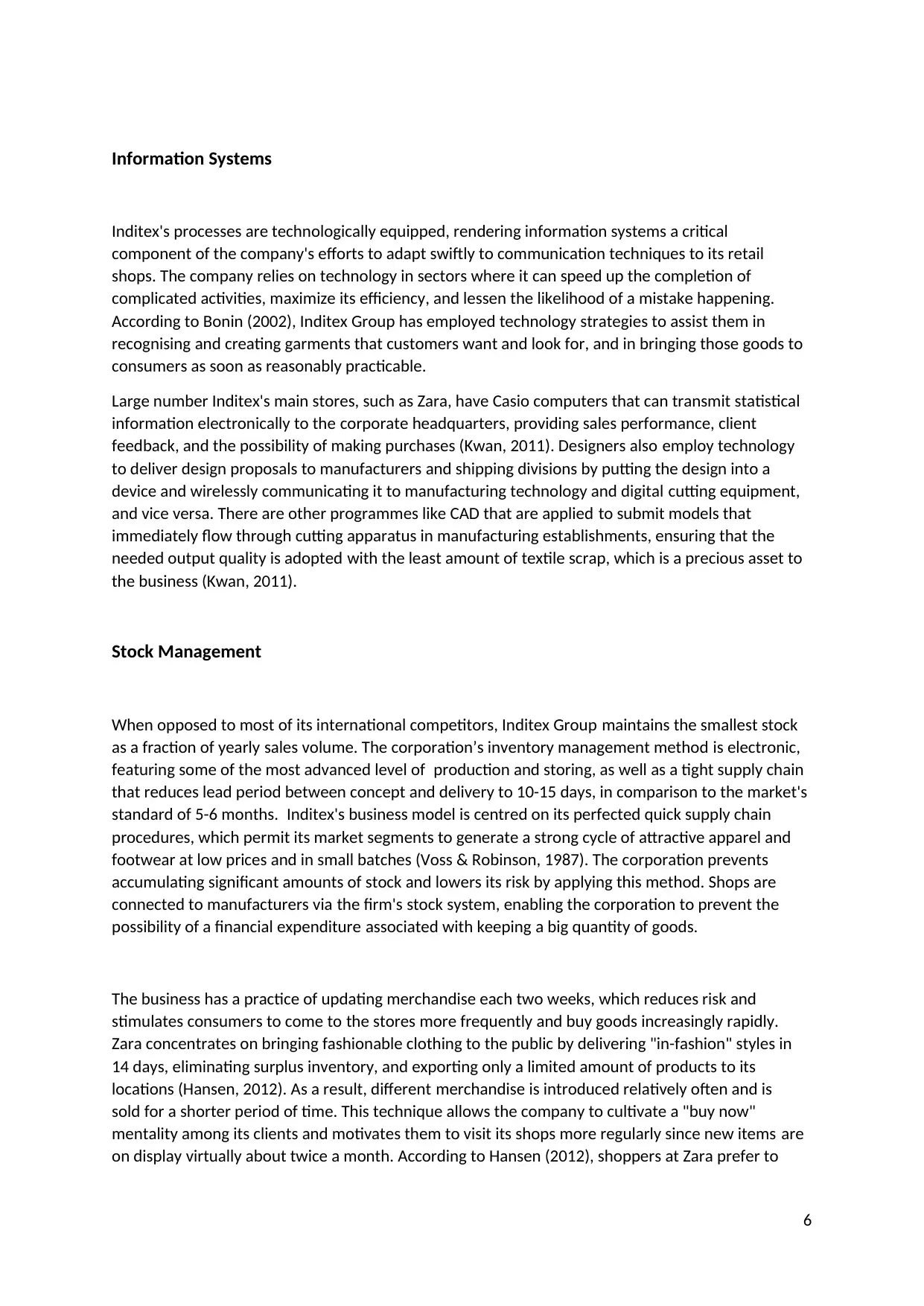
Information Systems
Inditex's processes are technologically equipped, rendering information systems a critical
component of the company's efforts to adapt swiftly to communication techniques to its retail
shops. The company relies on technology in sectors where it can speed up the completion of
complicated activities, maximize its efficiency, and lessen the likelihood of a mistake happening.
According to Bonin (2002), Inditex Group has employed technology strategies to assist them in
recognising and creating garments that customers want and look for, and in bringing those goods to
consumers as soon as reasonably practicable.
Large number Inditex's main stores, such as Zara, have Casio computers that can transmit statistical
information electronically to the corporate headquarters, providing sales performance, client
feedback, and the possibility of making purchases (Kwan, 2011). Designers also employ technology
to deliver design proposals to manufacturers and shipping divisions by putting the design into a
device and wirelessly communicating it to manufacturing technology and digital cutting equipment,
and vice versa. There are other programmes like CAD that are applied to submit models that
immediately flow through cutting apparatus in manufacturing establishments, ensuring that the
needed output quality is adopted with the least amount of textile scrap, which is a precious asset to
the business (Kwan, 2011).
Stock Management
When opposed to most of its international competitors, Inditex Group maintains the smallest stock
as a fraction of yearly sales volume. The corporation’s inventory management method is electronic,
featuring some of the most advanced level of production and storing, as well as a tight supply chain
that reduces lead period between concept and delivery to 10-15 days, in comparison to the market's
standard of 5-6 months. Inditex's business model is centred on its perfected quick supply chain
procedures, which permit its market segments to generate a strong cycle of attractive apparel and
footwear at low prices and in small batches (Voss & Robinson, 1987). The corporation prevents
accumulating significant amounts of stock and lowers its risk by applying this method. Shops are
connected to manufacturers via the firm's stock system, enabling the corporation to prevent the
possibility of a financial expenditure associated with keeping a big quantity of goods.
The business has a practice of updating merchandise each two weeks, which reduces risk and
stimulates consumers to come to the stores more frequently and buy goods increasingly rapidly.
Zara concentrates on bringing fashionable clothing to the public by delivering "in-fashion" styles in
14 days, eliminating surplus inventory, and exporting only a limited amount of products to its
locations (Hansen, 2012). As a result, different merchandise is introduced relatively often and is
sold for a shorter period of time. This technique allows the company to cultivate a "buy now"
mentality among its clients and motivates them to visit its shops more regularly since new items are
on display virtually about twice a month. According to Hansen (2012), shoppers at Zara prefer to
6
Inditex's processes are technologically equipped, rendering information systems a critical
component of the company's efforts to adapt swiftly to communication techniques to its retail
shops. The company relies on technology in sectors where it can speed up the completion of
complicated activities, maximize its efficiency, and lessen the likelihood of a mistake happening.
According to Bonin (2002), Inditex Group has employed technology strategies to assist them in
recognising and creating garments that customers want and look for, and in bringing those goods to
consumers as soon as reasonably practicable.
Large number Inditex's main stores, such as Zara, have Casio computers that can transmit statistical
information electronically to the corporate headquarters, providing sales performance, client
feedback, and the possibility of making purchases (Kwan, 2011). Designers also employ technology
to deliver design proposals to manufacturers and shipping divisions by putting the design into a
device and wirelessly communicating it to manufacturing technology and digital cutting equipment,
and vice versa. There are other programmes like CAD that are applied to submit models that
immediately flow through cutting apparatus in manufacturing establishments, ensuring that the
needed output quality is adopted with the least amount of textile scrap, which is a precious asset to
the business (Kwan, 2011).
Stock Management
When opposed to most of its international competitors, Inditex Group maintains the smallest stock
as a fraction of yearly sales volume. The corporation’s inventory management method is electronic,
featuring some of the most advanced level of production and storing, as well as a tight supply chain
that reduces lead period between concept and delivery to 10-15 days, in comparison to the market's
standard of 5-6 months. Inditex's business model is centred on its perfected quick supply chain
procedures, which permit its market segments to generate a strong cycle of attractive apparel and
footwear at low prices and in small batches (Voss & Robinson, 1987). The corporation prevents
accumulating significant amounts of stock and lowers its risk by applying this method. Shops are
connected to manufacturers via the firm's stock system, enabling the corporation to prevent the
possibility of a financial expenditure associated with keeping a big quantity of goods.
The business has a practice of updating merchandise each two weeks, which reduces risk and
stimulates consumers to come to the stores more frequently and buy goods increasingly rapidly.
Zara concentrates on bringing fashionable clothing to the public by delivering "in-fashion" styles in
14 days, eliminating surplus inventory, and exporting only a limited amount of products to its
locations (Hansen, 2012). As a result, different merchandise is introduced relatively often and is
sold for a shorter period of time. This technique allows the company to cultivate a "buy now"
mentality among its clients and motivates them to visit its shops more regularly since new items are
on display virtually about twice a month. According to Hansen (2012), shoppers at Zara prefer to
6
Paraphrase This Document
Need a fresh take? Get an instant paraphrase of this document with our AI Paraphraser
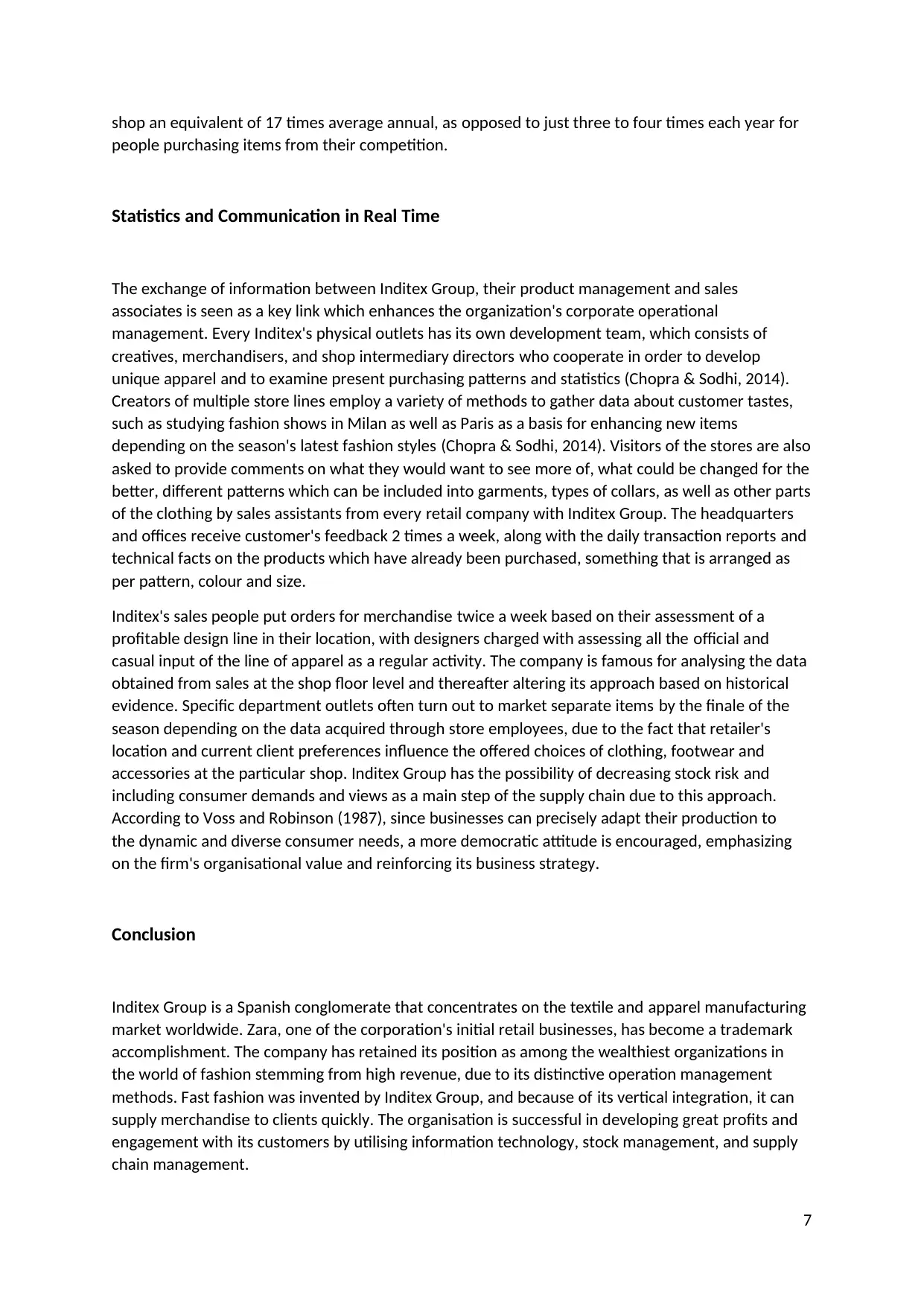
shop an equivalent of 17 times average annual, as opposed to just three to four times each year for
people purchasing items from their competition.
Statistics and Communication in Real Time
The exchange of information between Inditex Group, their product management and sales
associates is seen as a key link which enhances the organization's corporate operational
management. Every Inditex's physical outlets has its own development team, which consists of
creatives, merchandisers, and shop intermediary directors who cooperate in order to develop
unique apparel and to examine present purchasing patterns and statistics (Chopra & Sodhi, 2014).
Creators of multiple store lines employ a variety of methods to gather data about customer tastes,
such as studying fashion shows in Milan as well as Paris as a basis for enhancing new items
depending on the season's latest fashion styles (Chopra & Sodhi, 2014). Visitors of the stores are also
asked to provide comments on what they would want to see more of, what could be changed for the
better, different patterns which can be included into garments, types of collars, as well as other parts
of the clothing by sales assistants from every retail company with Inditex Group. The headquarters
and offices receive customer's feedback 2 times a week, along with the daily transaction reports and
technical facts on the products which have already been purchased, something that is arranged as
per pattern, colour and size.
Inditex's sales people put orders for merchandise twice a week based on their assessment of a
profitable design line in their location, with designers charged with assessing all the official and
casual input of the line of apparel as a regular activity. The company is famous for analysing the data
obtained from sales at the shop floor level and thereafter altering its approach based on historical
evidence. Specific department outlets often turn out to market separate items by the finale of the
season depending on the data acquired through store employees, due to the fact that retailer's
location and current client preferences influence the offered choices of clothing, footwear and
accessories at the particular shop. Inditex Group has the possibility of decreasing stock risk and
including consumer demands and views as a main step of the supply chain due to this approach.
According to Voss and Robinson (1987), since businesses can precisely adapt their production to
the dynamic and diverse consumer needs, a more democratic attitude is encouraged, emphasizing
on the firm's organisational value and reinforcing its business strategy.
Conclusion
Inditex Group is a Spanish conglomerate that concentrates on the textile and apparel manufacturing
market worldwide. Zara, one of the corporation's initial retail businesses, has become a trademark
accomplishment. The company has retained its position as among the wealthiest organizations in
the world of fashion stemming from high revenue, due to its distinctive operation management
methods. Fast fashion was invented by Inditex Group, and because of its vertical integration, it can
supply merchandise to clients quickly. The organisation is successful in developing great profits and
engagement with its customers by utilising information technology, stock management, and supply
chain management.
7
people purchasing items from their competition.
Statistics and Communication in Real Time
The exchange of information between Inditex Group, their product management and sales
associates is seen as a key link which enhances the organization's corporate operational
management. Every Inditex's physical outlets has its own development team, which consists of
creatives, merchandisers, and shop intermediary directors who cooperate in order to develop
unique apparel and to examine present purchasing patterns and statistics (Chopra & Sodhi, 2014).
Creators of multiple store lines employ a variety of methods to gather data about customer tastes,
such as studying fashion shows in Milan as well as Paris as a basis for enhancing new items
depending on the season's latest fashion styles (Chopra & Sodhi, 2014). Visitors of the stores are also
asked to provide comments on what they would want to see more of, what could be changed for the
better, different patterns which can be included into garments, types of collars, as well as other parts
of the clothing by sales assistants from every retail company with Inditex Group. The headquarters
and offices receive customer's feedback 2 times a week, along with the daily transaction reports and
technical facts on the products which have already been purchased, something that is arranged as
per pattern, colour and size.
Inditex's sales people put orders for merchandise twice a week based on their assessment of a
profitable design line in their location, with designers charged with assessing all the official and
casual input of the line of apparel as a regular activity. The company is famous for analysing the data
obtained from sales at the shop floor level and thereafter altering its approach based on historical
evidence. Specific department outlets often turn out to market separate items by the finale of the
season depending on the data acquired through store employees, due to the fact that retailer's
location and current client preferences influence the offered choices of clothing, footwear and
accessories at the particular shop. Inditex Group has the possibility of decreasing stock risk and
including consumer demands and views as a main step of the supply chain due to this approach.
According to Voss and Robinson (1987), since businesses can precisely adapt their production to
the dynamic and diverse consumer needs, a more democratic attitude is encouraged, emphasizing
on the firm's organisational value and reinforcing its business strategy.
Conclusion
Inditex Group is a Spanish conglomerate that concentrates on the textile and apparel manufacturing
market worldwide. Zara, one of the corporation's initial retail businesses, has become a trademark
accomplishment. The company has retained its position as among the wealthiest organizations in
the world of fashion stemming from high revenue, due to its distinctive operation management
methods. Fast fashion was invented by Inditex Group, and because of its vertical integration, it can
supply merchandise to clients quickly. The organisation is successful in developing great profits and
engagement with its customers by utilising information technology, stock management, and supply
chain management.
7
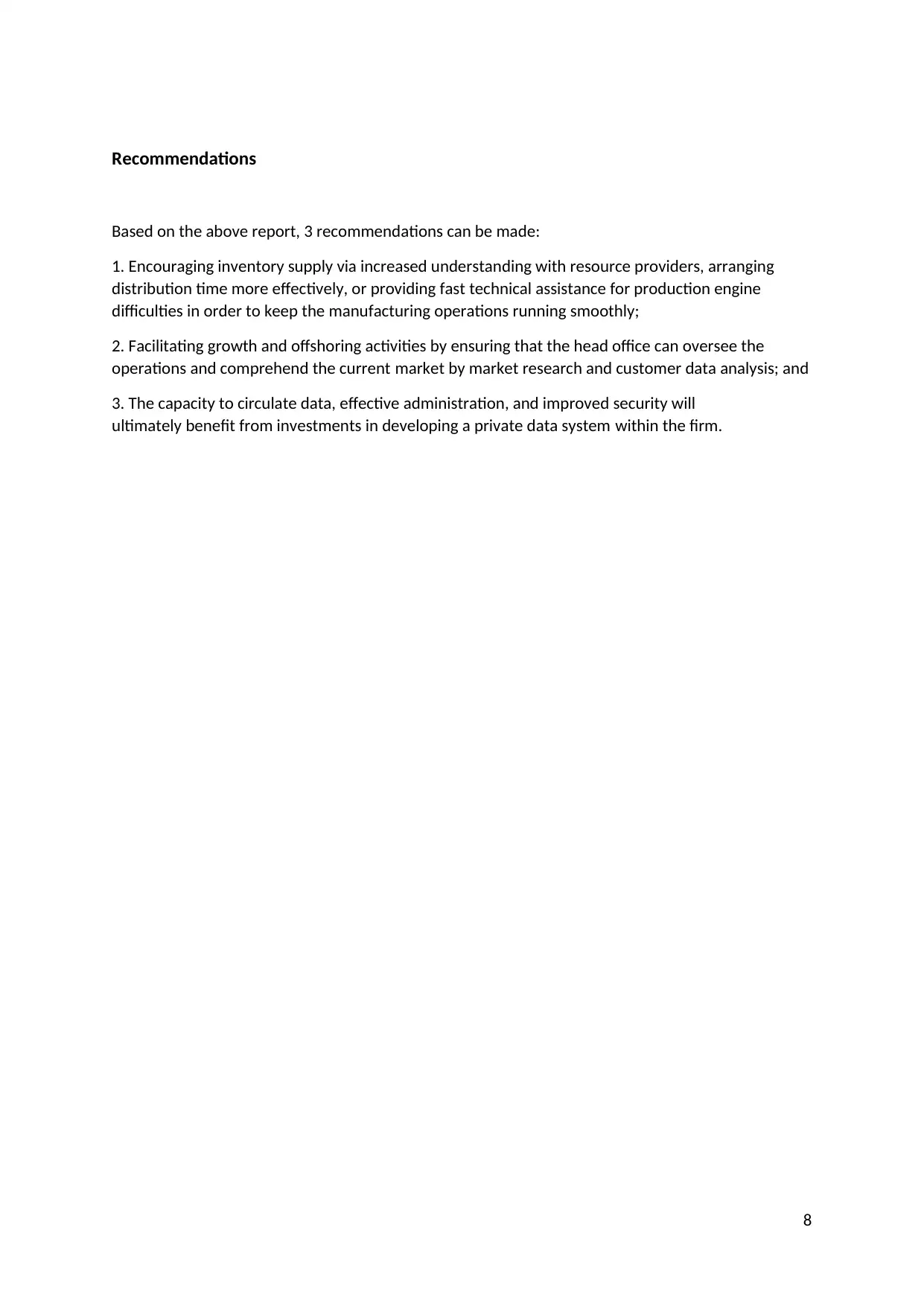
Recommendations
Based on the above report, 3 recommendations can be made:
1. Encouraging inventory supply via increased understanding with resource providers, arranging
distribution time more effectively, or providing fast technical assistance for production engine
difficulties in order to keep the manufacturing operations running smoothly;
2. Facilitating growth and offshoring activities by ensuring that the head office can oversee the
operations and comprehend the current market by market research and customer data analysis; and
3. The capacity to circulate data, effective administration, and improved security will
ultimately benefit from investments in developing a private data system within the firm.
8
Based on the above report, 3 recommendations can be made:
1. Encouraging inventory supply via increased understanding with resource providers, arranging
distribution time more effectively, or providing fast technical assistance for production engine
difficulties in order to keep the manufacturing operations running smoothly;
2. Facilitating growth and offshoring activities by ensuring that the head office can oversee the
operations and comprehend the current market by market research and customer data analysis; and
3. The capacity to circulate data, effective administration, and improved security will
ultimately benefit from investments in developing a private data system within the firm.
8
⊘ This is a preview!⊘
Do you want full access?
Subscribe today to unlock all pages.

Trusted by 1+ million students worldwide
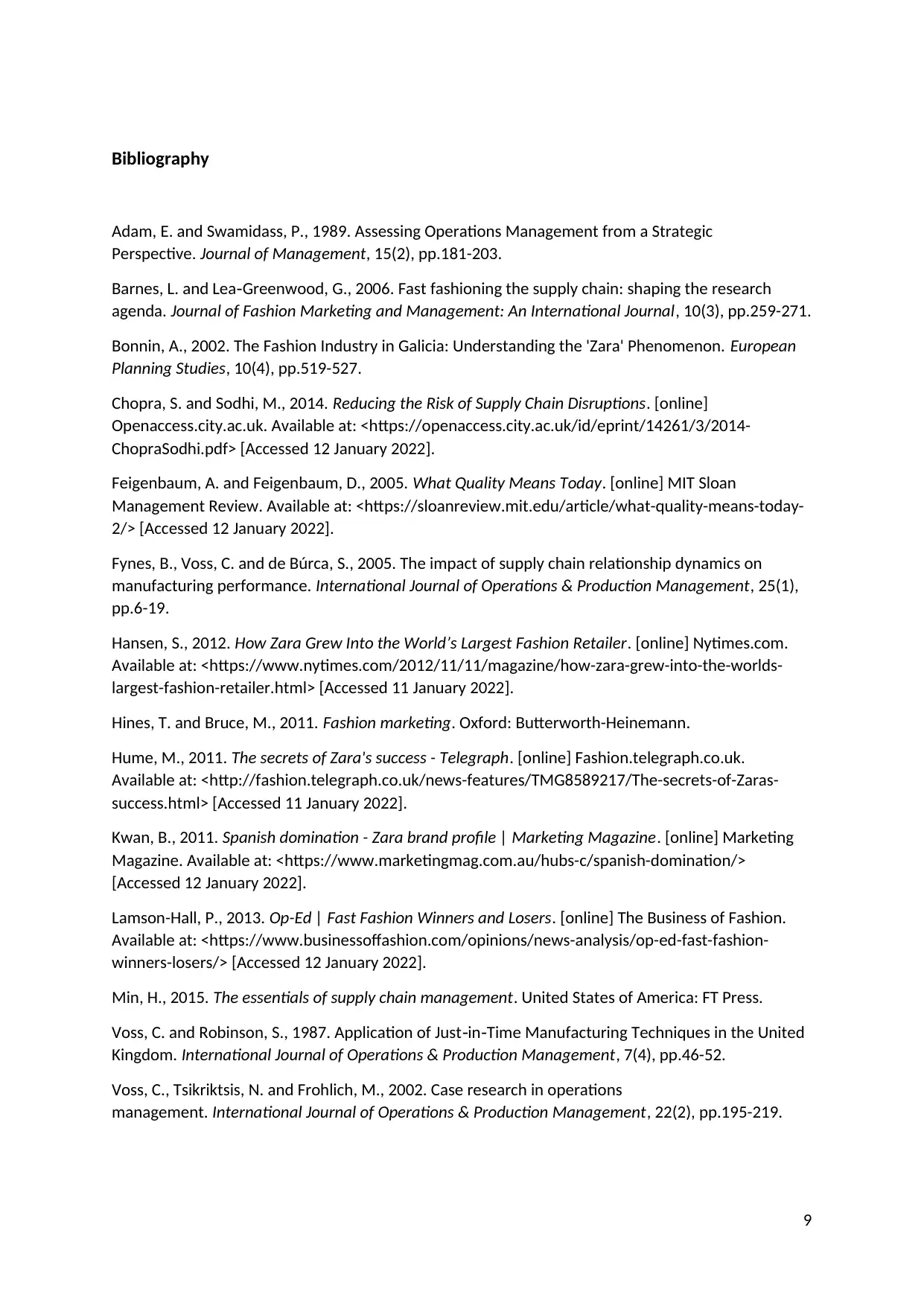
Bibliography
Adam, E. and Swamidass, P., 1989. Assessing Operations Management from a Strategic
Perspective. Journal of Management, 15(2), pp.181-203.
Barnes, L. and Lea Greenwood, G., 2006. Fast fashioning the supply chain: shaping the research‐
agenda. Journal of Fashion Marketing and Management: An International Journal, 10(3), pp.259-271.
Bonnin, A., 2002. The Fashion Industry in Galicia: Understanding the 'Zara' Phenomenon. European
Planning Studies, 10(4), pp.519-527.
Chopra, S. and Sodhi, M., 2014. Reducing the Risk of Supply Chain Disruptions. [online]
Openaccess.city.ac.uk. Available at: <https://openaccess.city.ac.uk/id/eprint/14261/3/2014-
ChopraSodhi.pdf> [Accessed 12 January 2022].
Feigenbaum, A. and Feigenbaum, D., 2005. What Quality Means Today. [online] MIT Sloan
Management Review. Available at: <https://sloanreview.mit.edu/article/what-quality-means-today-
2/> [Accessed 12 January 2022].
Fynes, B., Voss, C. and de Búrca, S., 2005. The impact of supply chain relationship dynamics on
manufacturing performance. International Journal of Operations & Production Management, 25(1),
pp.6-19.
Hansen, S., 2012. How Zara Grew Into the World’s Largest Fashion Retailer. [online] Nytimes.com.
Available at: <https://www.nytimes.com/2012/11/11/magazine/how-zara-grew-into-the-worlds-
largest-fashion-retailer.html> [Accessed 11 January 2022].
Hines, T. and Bruce, M., 2011. Fashion marketing. Oxford: Butterworth-Heinemann.
Hume, M., 2011. The secrets of Zara's success - Telegraph. [online] Fashion.telegraph.co.uk.
Available at: <http://fashion.telegraph.co.uk/news-features/TMG8589217/The-secrets-of-Zaras-
success.html> [Accessed 11 January 2022].
Kwan, B., 2011. Spanish domination - Zara brand profile | Marketing Magazine. [online] Marketing
Magazine. Available at: <https://www.marketingmag.com.au/hubs-c/spanish-domination/>
[Accessed 12 January 2022].
Lamson-Hall, P., 2013. Op-Ed | Fast Fashion Winners and Losers. [online] The Business of Fashion.
Available at: <https://www.businessoffashion.com/opinions/news-analysis/op-ed-fast-fashion-
winners-losers/> [Accessed 12 January 2022].
Min, H., 2015. The essentials of supply chain management. United States of America: FT Press.
Voss, C. and Robinson, S., 1987. Application of Just in Time Manufacturing Techniques in the United‐ ‐
Kingdom. International Journal of Operations & Production Management, 7(4), pp.46-52.
Voss, C., Tsikriktsis, N. and Frohlich, M., 2002. Case research in operations
management. International Journal of Operations & Production Management, 22(2), pp.195-219.
9
Adam, E. and Swamidass, P., 1989. Assessing Operations Management from a Strategic
Perspective. Journal of Management, 15(2), pp.181-203.
Barnes, L. and Lea Greenwood, G., 2006. Fast fashioning the supply chain: shaping the research‐
agenda. Journal of Fashion Marketing and Management: An International Journal, 10(3), pp.259-271.
Bonnin, A., 2002. The Fashion Industry in Galicia: Understanding the 'Zara' Phenomenon. European
Planning Studies, 10(4), pp.519-527.
Chopra, S. and Sodhi, M., 2014. Reducing the Risk of Supply Chain Disruptions. [online]
Openaccess.city.ac.uk. Available at: <https://openaccess.city.ac.uk/id/eprint/14261/3/2014-
ChopraSodhi.pdf> [Accessed 12 January 2022].
Feigenbaum, A. and Feigenbaum, D., 2005. What Quality Means Today. [online] MIT Sloan
Management Review. Available at: <https://sloanreview.mit.edu/article/what-quality-means-today-
2/> [Accessed 12 January 2022].
Fynes, B., Voss, C. and de Búrca, S., 2005. The impact of supply chain relationship dynamics on
manufacturing performance. International Journal of Operations & Production Management, 25(1),
pp.6-19.
Hansen, S., 2012. How Zara Grew Into the World’s Largest Fashion Retailer. [online] Nytimes.com.
Available at: <https://www.nytimes.com/2012/11/11/magazine/how-zara-grew-into-the-worlds-
largest-fashion-retailer.html> [Accessed 11 January 2022].
Hines, T. and Bruce, M., 2011. Fashion marketing. Oxford: Butterworth-Heinemann.
Hume, M., 2011. The secrets of Zara's success - Telegraph. [online] Fashion.telegraph.co.uk.
Available at: <http://fashion.telegraph.co.uk/news-features/TMG8589217/The-secrets-of-Zaras-
success.html> [Accessed 11 January 2022].
Kwan, B., 2011. Spanish domination - Zara brand profile | Marketing Magazine. [online] Marketing
Magazine. Available at: <https://www.marketingmag.com.au/hubs-c/spanish-domination/>
[Accessed 12 January 2022].
Lamson-Hall, P., 2013. Op-Ed | Fast Fashion Winners and Losers. [online] The Business of Fashion.
Available at: <https://www.businessoffashion.com/opinions/news-analysis/op-ed-fast-fashion-
winners-losers/> [Accessed 12 January 2022].
Min, H., 2015. The essentials of supply chain management. United States of America: FT Press.
Voss, C. and Robinson, S., 1987. Application of Just in Time Manufacturing Techniques in the United‐ ‐
Kingdom. International Journal of Operations & Production Management, 7(4), pp.46-52.
Voss, C., Tsikriktsis, N. and Frohlich, M., 2002. Case research in operations
management. International Journal of Operations & Production Management, 22(2), pp.195-219.
9
1 out of 10
Related Documents
Your All-in-One AI-Powered Toolkit for Academic Success.
+13062052269
info@desklib.com
Available 24*7 on WhatsApp / Email
![[object Object]](/_next/static/media/star-bottom.7253800d.svg)
Unlock your academic potential
Copyright © 2020–2025 A2Z Services. All Rights Reserved. Developed and managed by ZUCOL.




